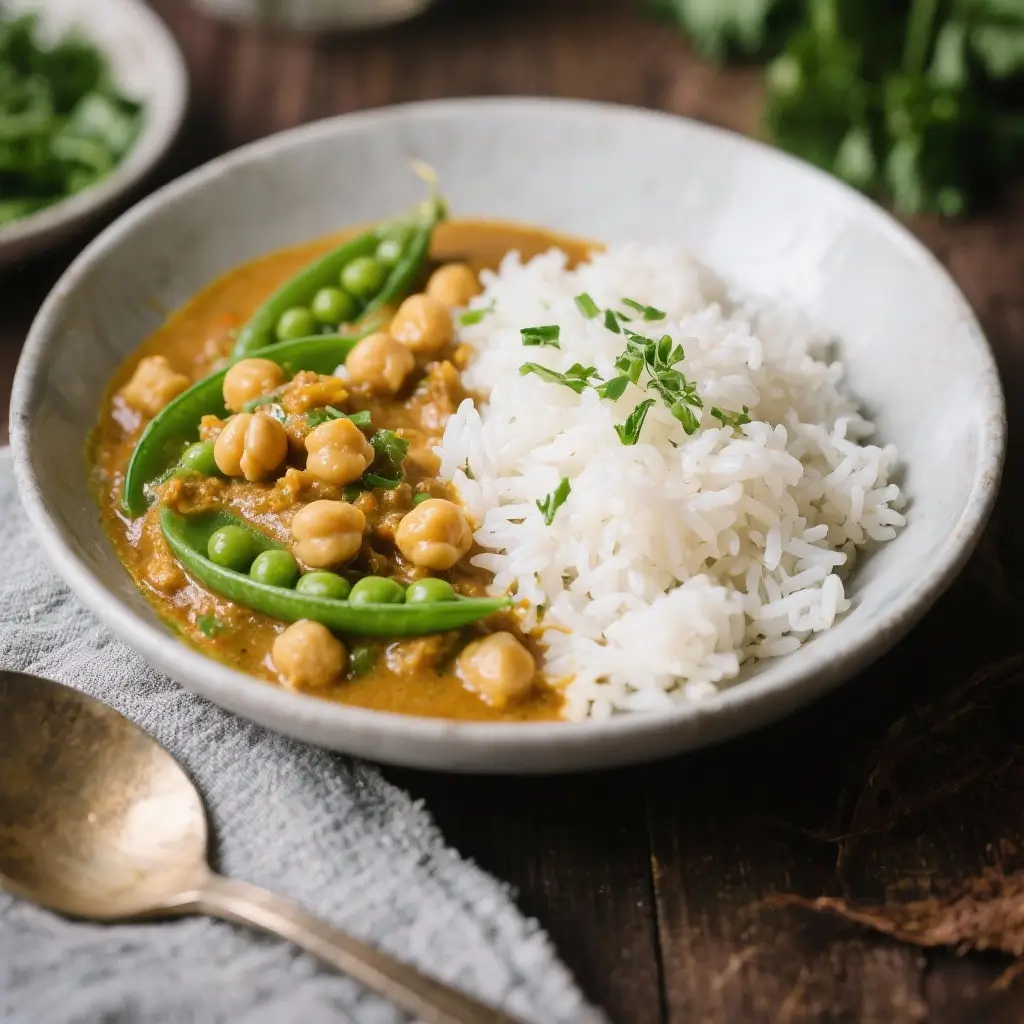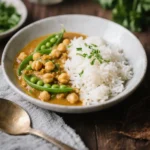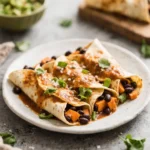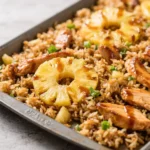Chickpea & Sweet Pea Curry with Coconut Rice: A Flavorful, Wholesome Meal
If you’re searching for a plant-based dish that’s rich in flavor, easy to prepare, and satisfying enough to become a weekly staple, look no further than this Chickpea & Sweet Pea Curry with Coconut Rice. This vibrant, aromatic curry combines the earthy depth of chickpeas with the subtle sweetness of peas, all simmered in a creamy coconut milk base infused with warming spices. Paired with fluffy coconut rice, it’s not just a meal—it’s an experience that brings comfort, nutrition, and global inspiration straight to your table.
The History Behind the Dish
The roots of this Chickpea & Sweet Pea Curry with Coconut Rice can be traced back to South Asian culinary traditions, particularly Indian and Sri Lankan cuisines, where legumes like chickpeas (also known as garbanzo beans) have been dietary staples for thousands of years. Chickpeas are one of the earliest cultivated legumes, dating back to 7500 BCE in the Middle East, and they spread across Asia, Africa, and the Mediterranean through ancient trade routes.
In Indian cuisine, chickpeas are central to dishes like chana masala and curries often served with rice or flatbreads. The use of coconut milk, however, is more prominent in coastal regions such as Kerala and Goa, where tropical coconuts grow abundantly. These areas blend coconut milk with spices to create luscious, creamy gravies that elevate simple ingredients into something luxurious.
This recipe fuses these two culinary heritages—North Indian spicing techniques and South Indian tropical richness—into a harmonious modern vegetarian dish. The addition of sweet peas adds a pop of color and freshness, making the curry both hearty and light. Meanwhile, coconut rice—a fragrant twist on plain steamed rice—adds a subtle sweetness and creamy texture that complements the bold flavors of the curry perfectly.
Today, this type of fusion reflects the global evolution of vegetarian cooking, where traditional elements meet contemporary tastes, resulting in accessible, nutritious, and deeply flavorful meals loved around the world.
Ingredients Breakdown
Understanding each ingredient in this recipe helps highlight how every component contributes to the overall taste, texture, and nutritional profile of the dish. Let’s explore them in detail:
- Chickpeas: Also known as garbanzo beans, these legumes are packed with protein, fiber, and essential minerals like iron and folate. They provide a meaty texture and absorb flavors beautifully during cooking.
- Sweet Peas: Fresh or frozen green peas add natural sweetness, vibrant color, and a burst of freshness. They’re rich in vitamins A, C, and K, as well as antioxidants.
- Coconut Milk: Full-fat canned coconut milk gives the curry its creamy consistency and tropical aroma. It contains healthy medium-chain triglycerides (MCTs), which may support metabolism and heart health when consumed in moderation.
- Onion, Garlic, and Ginger: The holy trinity of aromatics forms the flavor base. Onions bring sweetness, garlic adds pungency, and ginger lends warmth and zing—all crucial for building depth in the sauce.
- Tomatoes: Whether fresh or canned, tomatoes contribute acidity and body to the curry, helping balance the richness of the coconut milk.
- Spices: Turmeric provides earthiness and anti-inflammatory benefits; cumin adds smokiness; coriander offers citrusy notes; garam masala brings warmth and complexity; chili powder controls heat level. Together, they create a symphony of flavor.
- Fresh Herbs: Cilantro (coriander leaves) is used generously for garnish, adding brightness and freshness. Lime juice at the end enhances the overall zest.
- Basmati Rice: A long-grain aromatic rice that pairs perfectly with curries due to its light, fluffy texture and delicate fragrance.
- Coconut Flakes or Coconut Cream (for rice): Adds a subtle sweetness and tropical essence to the rice, elevating it beyond ordinary side dishes.
- Olive Oil or Coconut Oil: Used for sautéing, these oils enhance flavor while supporting nutrient absorption from fat-soluble vitamins in spices and vegetables.
Step-by-Step Recipe
For the Coconut Rice:
- Rinse 1 cup of basmati rice under cold water until the water runs clear to remove excess starch.
- In a medium saucepan, combine the rinsed rice, 1¾ cups of water, ½ cup of unsweetened coconut milk, and ¼ teaspoon of salt.
- Optional: Add 2 tablespoons of shredded dried coconut flakes for extra texture and flavor.
- Bring the mixture to a boil over high heat, then reduce to low, cover tightly, and simmer for 15–18 minutes, or until all liquid is absorbed and rice is tender.
- Remove from heat and let it sit, covered, for 10 minutes. Fluff with a fork before serving. Stir in a squeeze of lime juice and chopped cilantro if desired.
For the Chickpea & Sweet Pea Curry:
- Heat 2 tablespoons of coconut oil or olive oil in a large pot or deep skillet over medium heat.
- Add 1 finely chopped onion and sauté for 5–6 minutes until translucent and beginning to caramelize.
- Add 3 minced garlic cloves and 1 tablespoon of freshly grated ginger; cook for another minute until fragrant.
- Stir in 1 tablespoon ground cumin, 1 tablespoon ground coriander, 1½ teaspoons turmeric, 1 teaspoon garam masala, and ½ teaspoon chili powder (adjust to taste). Toast the spices for 30 seconds to release their essential oils.
- Add 1 diced tomato (or ½ cup crushed canned tomatoes) and cook for 3–4 minutes until softened and the mixture begins to thicken.
- Pour in 1 can (13.5 oz / 400 ml) of full-fat coconut milk and 1 cup of vegetable broth. Stir well to combine.
- Add 2 cans (15 oz each) of drained and rinsed chickpeas. Simmer gently for 15 minutes to allow flavors to meld.
- Stir in 1 cup of sweet peas (fresh or thawed frozen peas) and cook for an additional 5 minutes until heated through.
- Season with salt and pepper to taste. Finish with the juice of half a lime and a generous handful of chopped fresh cilantro.
- Taste and adjust seasoning—add more spice, lime, or salt as needed.
Tips for Perfect Results
- Rinse Chickpeas Well: Always drain and rinse canned chickpeas to remove excess sodium and the starchy liquid that can make the curry too thick or foamy.
- Bloom the Spices: Never skip toasting the spices after sautéing onions and aromatics. This step unlocks deeper, more complex flavors.
- Use Full-Fat Coconut Milk: Light coconut milk will result in a thinner, less creamy curry. For best texture and richness, stick with full-fat varieties.
- Dry Toast Option: For even more depth, try dry-toasting whole spices (like cumin seeds and coriander seeds) before grinding them yourself.
- Simmer Gently: Avoid boiling the coconut milk vigorously, as it may separate. Keep the heat at a gentle simmer once added.
- Rest Before Serving: Like many curries, this dish tastes better after resting for 10–15 minutes off the heat, allowing flavors to deepen.
- Adjust Consistency: If the curry becomes too thick, thin it with a splash of warm water or vegetable broth. If too thin, simmer uncovered for a few extra minutes.
- Make Ahead Friendly: This curry reheats beautifully and often improves overnight as the spices mellow and infuse the ingredients.
Variations and Customizations
This recipe is incredibly versatile and welcomes creativity. Here are some delicious ways to customize it based on dietary needs, preferences, or seasonal availability:
- Vegan & Gluten-Free: Naturally vegan and gluten-free (ensure all packaged ingredients like broth and spices are certified GF), making it ideal for various diets.
- Add Vegetables: Include diced bell peppers, spinach, kale, carrots, cauliflower, or zucchini for added nutrients and texture. Sauté them with the onions or stir leafy greens in at the end.
- Protein Boost: Add paneer (Indian cottage cheese), tofu, tempeh, or cooked lentils for extra protein. For non-vegetarian versions, shredded chicken or shrimp work well.
- Spice Level: Control the heat by adjusting chili powder or adding fresh green chilies. For extra kick, include a pinch of cayenne or red pepper flakes.
- Herb Swaps: Replace cilantro with parsley or mint if you dislike coriander flavor. Basil also works surprisingly well with coconut milk.
- Curry Base Variations: Try using roasted red peppers or butternut squash purée for a sweeter, creamier alternative to tomatoes.
- Dairy Twist: Stir in a spoonful of Greek yogurt at the end for tanginess (not vegan) or use cashew cream for a dairy-free creamy finish.
- Grain Alternatives: Serve over quinoa, millet, brown rice, or cauliflower rice for different textures and nutritional profiles.
- Canned vs. Dried Chickpeas: While canned are convenient, soaked and cooked dried chickpeas offer superior texture and lower sodium. Cook ¾ cup dried chickpeas in 3 cups water until tender (~1.5 hours).
Health Considerations and Nutritional Value
This Chickpea & Sweet Pea Curry with Coconut Rice isn’t just delicious—it’s a powerhouse of nutrition. Here’s why it deserves a spot in your healthy eating routine:
- High in Plant-Based Protein: Chickpeas provide about 15 grams of protein per cup, making this a filling and satisfying vegetarian main course.
- Rich in Fiber: With nearly 12 grams of fiber per serving, this dish supports digestive health, stabilizes blood sugar, and promotes satiety.
- Healthy Fats: Coconut milk contains lauric acid and MCTs, which may boost good HDL cholesterol and provide quick energy. Use in moderation if monitoring saturated fat intake.
- Antioxidant-Rich: Turmeric contains curcumin, a potent anti-inflammatory compound. Pair it with black pepper (often in garam masala) to increase absorption.
- Vitamin-Packed: Peas deliver vitamin K for bone health, vitamin C for immunity, and folate for cell function. Tomatoes contribute lycopene, especially when cooked.
- Low Glycemic Index: The combination of fiber, protein, and healthy fats helps prevent blood sugar spikes, making it suitable for diabetics when portion-controlled.
- Supports Heart Health: Legumes and whole grains are linked to reduced risk of cardiovascular disease due to their fiber and nutrient content.
- Allergen Notes: Contains coconut (a tree nut allergen). For nut-free versions, substitute coconut milk with oat milk blended with sunflower seeds or soy cream, though flavor will vary.
Estimated Nutritional Value (per serving, serves 6):
- Calories: ~380 kcal
- Protein: 12g
- Fat: 18g (Saturated Fat: 13g)
- Carbohydrates: 45g
- Fiber: 11g
- Sugar: 8g (naturally occurring)
- Sodium: 450mg (varies based on added salt and canned products)
Full Ingredients List
For the Coconut Rice:
- 1 cup basmati rice
- 1¾ cups water
- ½ cup full-fat coconut milk
- ¼ teaspoon salt
- 2 tablespoons unsweetened shredded coconut (optional)
- 1 tablespoon fresh cilantro, chopped
- 1 teaspoon lime juice
For the Chickpea & Sweet Pea Curry:
- 2 tablespoons coconut oil or olive oil
- 1 large yellow onion, finely chopped
- 3 garlic cloves, minced
- 1 tablespoon fresh ginger, grated
- 1 tablespoon ground cumin
- 1 tablespoon ground coriander
- 1½ teaspoons ground turmeric
- 1 teaspoon garam masala
- ½ teaspoon chili powder (adjust to taste)
- 1 medium tomato, diced (or ½ cup crushed canned tomatoes)
- 1 can (13.5 oz / 400 ml) full-fat coconut milk
- 1 cup vegetable broth
- 2 cans (15 oz each) chickpeas, drained and rinsed
- 1 cup sweet peas (frozen or fresh)
- Salt and black pepper to taste
- Juice of ½ lime
- ¼ cup fresh cilantro, chopped (plus more for garnish)
Directions
- Prepare the Coconut Rice: Rinse basmati rice thoroughly. In a saucepan, combine rice, water, coconut milk, salt, and optional coconut flakes. Bring to a boil, then reduce heat to low, cover, and simmer for 15–18 minutes. Remove from heat and let stand for 10 minutes. Fluff with a fork and stir in lime juice and cilantro.
- Sauté Aromatics: In a large pot or Dutch oven, heat oil over medium heat. Add onion and cook until soft and golden (5–7 minutes). Stir in garlic and ginger; cook for 1 minute until fragrant.
- Bloom Spices: Add cumin, coriander, turmeric, garam masala, and chili powder. Stir constantly for 30 seconds to toast the spices without burning.
- Add Tomato Base: Stir in diced tomato and cook for 3–4 minutes until broken down and slightly thickened.
- Create the Curry Sauce: Pour in coconut milk and vegetable broth. Whisk well to combine and bring to a gentle simmer.
- Add Chickpeas: Stir in the chickpeas, ensuring they are fully submerged in the sauce. Simmer uncovered for 15 minutes, stirring occasionally.
- Incorporate Peas: Add sweet peas and cook for 5 more minutes until tender and heated through.
- Season and Finish: Taste and season with salt and pepper. Stir in lime juice and fresh cilantro. Adjust spices or acidity as needed.
- Serve: Spoon warm coconut rice into bowls and top generously with chickpea and pea curry. Garnish with extra cilantro, a lime wedge, and a sprinkle of red chili flakes if desired.
FAQ (Frequently Asked Questions)
Can I make this curry ahead of time?
Yes! This curry tastes even better the next day as the flavors deepen. Store in an airtight container in the refrigerator for up to 4 days or freeze for up to 3 months.
Is this recipe freezer-friendly?
Absolutely. Freeze the curry (without rice) in portion-sized containers for up to 3 months. Thaw overnight in the fridge and reheat gently on the stove, adding a splash of water or broth if needed.
Can I use light coconut milk?
You can, but the curry will be significantly less creamy and rich. For a healthier yet still creamy option, blend half coconut milk with half unsweetened almond milk and a tablespoon of tahini.
What can I serve with this curry besides rice?
Try naan bread, roti, paratha, or quinoa. A side of raita (yogurt with cucumber and mint) or mango chutney also pairs beautifully.
Why did my coconut milk separate?
Coconut milk can separate if boiled too rapidly. Always keep the heat at a gentle simmer after adding it. If separation occurs, whisk vigorously or blend briefly with an immersion blender to re-emulsify.
Are there any instant pot or slow cooker options?
Yes! For Instant Pot: Sauté aromatics using the “Sauté” function, then add all curry ingredients except peas and cilantro. Pressure cook for 5 minutes, quick release, stir in peas and finish as directed. For Slow Cooker: Combine everything except peas, cilantro, and lime juice. Cook on low for 6–7 hours or high for 3–4. Add peas in the last 30 minutes.
Can I omit onions or garlic for low-FODMAP diets?
Yes. Use garlic-infused oil instead of fresh garlic, and replace onion with chopped green onion tops (scallions, green part only) or shallots in small amounts, depending on tolerance.
How do I make this oil-free?
Sauté the onions and spices using water, vegetable broth, or a non-stick pan. The final texture will be slightly different but still flavorful.
Summary
Indulge in a comforting bowl of Chickpea & Sweet Pea Curry simmered in creamy coconut milk and aromatic spices, served over fragrant coconut rice for a truly soul-warming meal. Packed with plant-based protein, fiber, and vibrant flavors, this dish is as nourishing as it is delicious—perfect for weeknight dinners or impressing guests.










